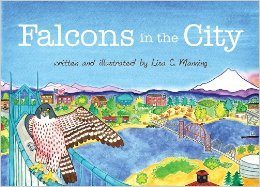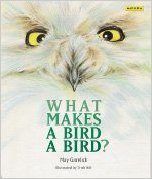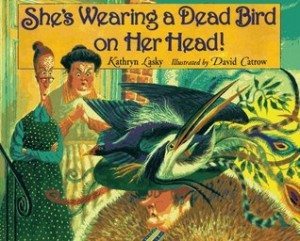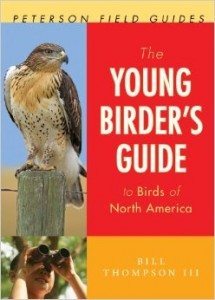Great Bird Books for Kids
By Marissa Ortega-Welch
As an educator for Golden Gate Bird Alliance, I’m always searching for great books about birds to share with my students. I’ll admit I’m very picky. The books have to teach a concept but still be easy to read (3rd grade reading level). They should be factually-based but still entertaining, with good illustrations. And here’s my real pet peeve – they can’t be too East Coast-centric in the birds represented.
Here are a few gems I’ve discovered recently and shared with my students. They’d make good holiday gifts for the young birders in anyone’s life.
Falcons in the City, written and illustrated by Lisa Manning.
Told from the perspective of “Frida,” a juvenile Peregrine Falcon, this book is based on the true story of a Peregrine Falcon nest on the Fremont Bridge in Portland, Oregon. Frida talks young readers through the life of an urban Peregrine and the exciting moment when she and her siblings fledge. Her brothers end up in the Williamette River and are rescued by birders who have been watching the nest (one of them sporting an “Audubon” shirt).

Frida also explains how Peregrine Falcons have made a remarkable comeback from near extinction. The illustrations are warm and child-friendly; the story is readable for beginner readers; and young birders will be excited to learn that this is a true story and very similar to the Peregrine Falcon nests we have here in the Bay Area. Maybe someone here could write a short story about our Peregrines fledging from the Fruitvale Avenue bridge in Oakland?
What Makes a Bird a Bird? by May Garelick. Illustrated by Trish Hill.
May Garelick’s book talks readers through questioning what makes a bird a bird: Is it a bird because it flies? Is it a bird because it has wings? Because it builds a nest? Lays eggs? Sings?

She introduces readers to a variety of birds that appear to be the exception to what we commonly think of as birds – penguins and ostriches that can’t fly and oystercatchers that don’t build nests. It’s an interesting question for even us adults to ponder: What is the one thing common to all birds that sets them apart from other animals? Read Garelick’s book if you can’t figure it out.
She’s Wearing a Dead Bird on Her Head, by Kathryn Lasky. Illustrated by David Catrow.
This book tells the story of real-life Harriet Hemenway and Minna Hall, members of the Massachusetts Audubon Society, one of the earliest Audubon societies. The women were Boston socialites at the turn of the twentieth century who were appalled by the mass slaughter of birds for plumage on hats. They used their position in society to lobby for laws banning the sale of native bird plumes in the U.S.

Hemenway and Hall were also suffragists and their story is one of empowered women who spoke out about what they believed during a time when it wasn’t fashionable for woman to do so. Lasky’s story is fun and engaging, and Catrow’s detailed illustrations of the bird-hats stretch and take over the page.
Peterson Field Guide Coloring Books: Birds by Peter Alden, Roger Peterson, and John Sill.
Peterson has designed a series of field guides that are also coloring books! The book contains over 200 birds of North America in black and white outline, along with color stickers of all the birds. Young birders can match the sticker with the black and white bird and color away, learning about bird plumage in the process!

The guide also contains a short description of each bird, similar to a regular field guide. Some birds are featured in a landscape setting that can also be colored, teaching young birders about different habitats. These coloring books are an excellent tool in helping young birders (and even adult ones too) to notice detail in the birds. I personally want one for myself.
Peterson Field Guide: The Young Birder’s Guide to the Birds of North America, by Bill Thompson.
This is a great kid-friendly bird field guide, probably best suitable for birders ages 8 to 11. It is organized like a regular field guide but includes a lot more text and photos. Each bird gets its own page that describes the bird and its life history.

The book is also full of other fun facts about birds. It would serve well as a guide out in the field but I can imagine a really enthusiastic young birder pouring over it at home too. Its one limitation as a field guide is that it includes birds from all over North America. A West Coast version would be ideal.
——————————
Marissa Ortega-Welch is Eco-Education Coordinator for Golden Gate Bird Alliance, where each year she helps introduce 700 low-income elementary schoolchildren to the wildlife and ecosystems in their neighborhoods. Her last post for this blog was “11 Rules for the Twenty-something Birdwatcher.“
